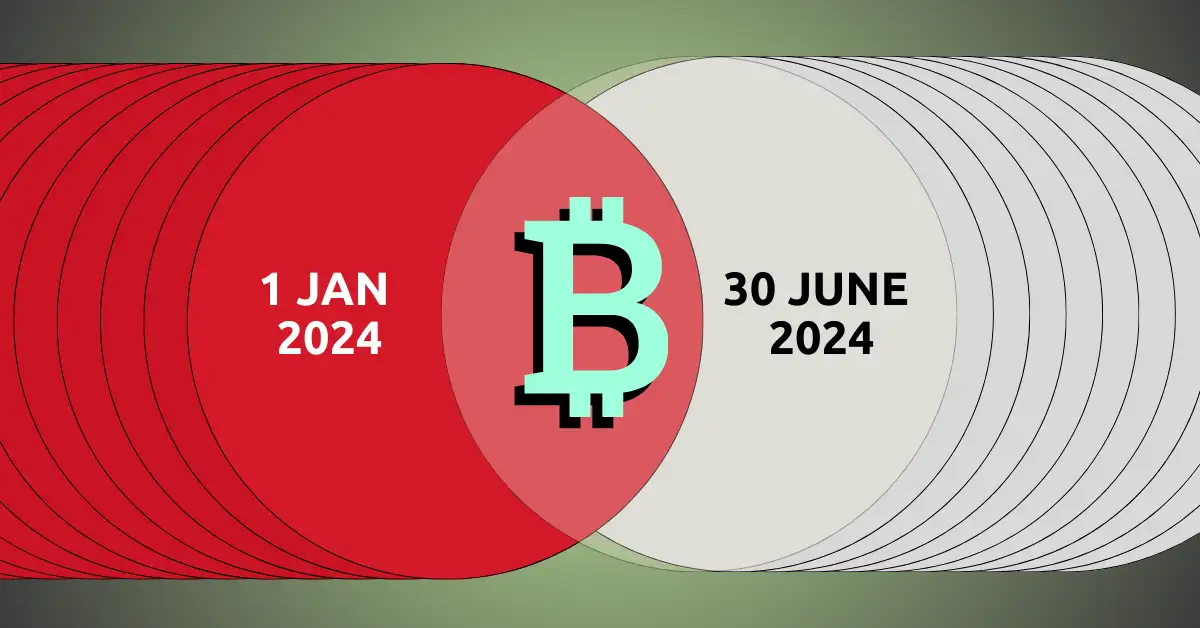Regulation
ETF Approvals, Regulatory Frameworks, and Market Dynamics

The first half of 2024 was a challenging time for the crypto market. There was an increase in both regulatory scrutiny and institutional adoption. Despite these challenges, the market has shown an upward momentum, with the total crypto market capitalization increasing over the past six months.
The crypto industry is gaining institutional adoption, so it’s important to review significant market developments regularly. The crypto markets peaked in late 2021, and we are now nearing the three-year mark since that peak. This is a good time to step back and examine the state of the markets and key developments in various areas of the Web3 space.
Today, we will look at Coinpedia’s half-year report for the first half of 2024. We will explore the landscape of major crypto and Web3 sectors, including layer-1 and layer-2 solutions, stablecoins, decentralized finance, non-fungible tokens, and institutional adoption.
Top Crypto News In H1 2024
SEC-approved spot Bitcoin ETF trading
The US Securities and Exchange Commission (SEC) approved US-listed Bitcoin exchange-traded funds (ETFs) in January. The SEC I approved 11 applications from BlackRock, Ark Investments, Fidelity, Invesco, VanEck, and others to launch ETFs tracking Bitcoin, despite warnings from officials and investor advocates about associated risks.
The Bitcoin ETFs are listed on the New York Stock Exchange (NYSE), Nasdaq, and Chicago Board Options Exchange (CBOE).
US House passed crypto bill despite warnings from SEC
In May, the U.S. House of Representatives passed a bill to establish a new legal framework for crypto currencies, despite a warning from the U.S. securities regulator about potential financial risks.
US passed the “Financial Innovation and Technology for the 21st Century Act,” establishing a regulatory framework for cryptocurrencies and outlining the responsibilities of the Commodity Futures Trading Commission (CFTC) and the Securities and Exchange Commission (SEC).
Sam Bankman-Fried sentenced to 25 years in prison
Crypto entrepreneur Sam Bankman-Fried was sentenced to 25 years in prison for defrauding hundreds of thousands of customers after the collapse of FTX, a popular digital currency exchange.
Despite acknowledging Bankman-Fried’s intelligence, U.S. District Judge Lewis A. Kaplan harshly criticized him and his crimes before issuing a sentence that was half of what prosecutors wanted and much less than the 105 years recommended by probation officers.
SEC accelerates spot Ether ETF approval process
The U.S. Securities and Exchange Commission could approve ether spot price exchange-traded funds (ETFs) by July 4, as talks between asset managers and regulators reach the final stages, sources told Reuters. It previously gave an initial greenlight for spot Ether ETF in May.
Eight asset managers, including BlackRock, VanEck, Franklin Templeton, and Grayscale Investments, seek SEC approval for the funds.
Terraform Labs and Do Kwon agreed to pay the SEC a combined $4.5 billion in a civil fraud case
Terraform Labs and its former CEO Do Kwon have agreed to a settlement with the SEC to pay $4.5 billion in disgorgement and civil penalties. The settlement also permanently bans Kwon and Terraform Labs from trading crypto asset securities, including all tokens in the Terra ecosystem.
Binance faced trouble in Nigeria
Binance, the world’s largest cryptocurrency exchange, is facing legal battles in Nigeria as the country cracks down on the industry for allegedly facilitating criminal activity and undermining the naira.
In February, two Binance senior executives, Tigran Gambaryan and Nadeem Anjarwalla, were arrested in Nigeria for allegedly ignoring criminal activities like tax evasion and money laundering.
According to the government, Binance is responsible for weakening the Naira currency. In the first half of 2024, the Nigerian currency depreciated by nearly 40%, marking it as the worst-performing currency during that time.
Overview of the Crypto Market Cap
In the initial six months of 2024, 89% of sectors witnessed a reduction in market capitalization, with more than 30 industries experiencing losses ranging from 20% to 40% in value. During the second quarter, only three sectors recorded positive growth, underscoring the tough market conditions.
Nevertheless, certain “unicorns” have managed to continue their expansion and increase their market presence. Following a surge in Memecoin popularity in March and early April, the market’s attention has returned to stablecoins, which saw an 8.6% increase in market cap, as well as AI and big data sectors, which grew by 2.5%.
The total crypto market started peaking from $1.7 trillion and due to the launch of the Bitcoin ETF it made a high near $2.75 trillion in March. However, the market cap then declined toward $2 trillion in May following bearish market sentiment and several pump and dump news.
Blockchain Upgrades And Performance: Layer 1 And Layer 2
Ethereum Dencun Upgrade
Ethereum, ranking second only to Bitcoin, implemented the eagerly awaited “Dencun” upgrade. This upgrade aims to boost growth on layer-2 networks such as Arbitrum and Polygon by lowering their data fees. Technically classified as a hard fork in blockchain terms, the Dencun upgrade was initiated at Ethereum epoch 269,568 at 13:55 UTC (9:55 a.m. ET) and completed at 14:10 UTC on 13 March.
Layer 1 Blockchains
The total market cap for Layer 1 Smart Contracts stands at $696 billion, down 3.57%. Ethereum leads among major L1s with a 62 % dominance, its highest since 2024, triggered by the SEC’s approval of Ethereum Spot ETFs.
BNB and Solana saw market cap increases of $42 billion and $18 billion YTD, respectively, boosting their market shares. Solana tops in daily active addresses with over 1.6 million, followed by BNB with 1 million. Both SUI and TON ecosystems have experienced increased network activity in the first half of 2024 due to recent grants and popular projects.
Layer 2 Blockchains
| L2 Chain | Type | TVL (Start of H1) | TVL (End of H1) | % Gain |
| Mode Network | Optimistic Rollup | $26.51M | $718.3M | 2609.54% |
| Base | Optimistic Rollup | $742.63M | $7.6B | 920.70% |
| Starknet | ZK Rollup | $144.88M | $1.2B | 693.76% |
| Linea | ZK Rollup | $186.75M | $1.2B | 553.28% |
| Mantle | Optimum | $222.48M | $1.3B | 466.34% |
| Blast | Optimistic Rollup | $1.00B | $3.2B | 223.00% |
| Arbitrum One | Optimistic Rollup | $10.88B | $19.1B | 75.55% |
| zkSync Era | ZK Rollup | $602.75M | $881.1M | 46.18% |
| Manta Pacific | Optimum | $619.98M | $905.4M | 46.03% |
| OP Mainnet | Optimistic Rollup | $6.32B | $7.8B | 23.26% |
Arbitrum and Base saw the biggest TVL increases in the first half of the year, with gains of $8.2 billion and $6.8 billion, respectively. Coinbase’s Base Network has quickly become a standout since its launch in August 2023, now ranking as the third-largest L2 by TVL, only behind Arbitrum and Optimism.
Base has gained traction thanks to its active developer community, which deploys a record 22,000 contracts daily, attracting major apps like Friend.Tech and Farcaster.
In April, Linea’s user activity spiked with the launch of its “Linea Voyage: The Surge” campaign, which encouraged users to engage with DeFi protocols for a chance to win airdrop points.
In early May, Arbitrum experienced a boost in transactions, likely driven by a rise in DeFi activities, as Uniswap (Arbitrum) transaction volume exceeded $150 billion.
By June, Base had surpassed Arbitrum in user activity, probably due to the launch of Coinbase’s smart wallet, which allows users to transact on-chain on Base without gas fees.
However, Mode Network had the highest percentage gain in TVL, growing 26 times since its January 2024 mainnet launch. Mode, a DeFi-focused L2 built on the OP stack and supported by Optimism, EigenLayer, Renzo, and EtherFi, has seen significant growth primarily due to its successful airdrop campaign.
Stablecoin Performance In H1 2024
Fiat-collateralized stablecoins dominate 96.6% of the total real-world assets market cap, followed by government securities at 1.65%, commodities at 1.21%, and other categories.
USDT remains the leading stablecoin, achieving new market cap highs and growing by 22.4% in the year’s first half. It remains the most traded token and serves as the base pair for nearly 70% of all spot trading volume on centralized exchanges.
After a decline last year, USDC recovered and increased its market cap by 32%. This growth is likely due to Circle’s efforts to attract institutional clients and the establishment of Coinbase International, which expanded USDC’s presence in markets outside the U.S.
Launched in February 2024, Ethena’s USDe has seen a remarkable 934% increase in market cap. Offering a high yield of 33.5%, USDe has attracted significant capital. Despite the airdrop and the launch of its native token ENA, USDe’s market cap continues to expand.
Senators Introduced Stablecoin Bill
On April 17, 2024, Senators Kirsten Gillibrand and Cynthia Lummis introduced the bipartisan Lummis-Gillibrand Payment Stablecoin Act. This bill regulates payment stablecoins, aims to protect consumers, ensure U.S. dollar dominance, and upholds the dual banking system.
It limits stablecoin issuance to U.S. dollar-backed ones approved by regulators, excluding algorithmic types. The Federal Reserve supervises these arrangements, ensuring one-to-one reserves and adherence to U.S. financial regulations. The bill was developed with insights from major U.S. regulatory bodies.
Ripple Plans To Launch Stablecoin
On April 4, Ripple revealed plans to introduce its own stablecoin, pegged 1:1 to the US dollar, later this year alongside XRP. This move is seen as crucial for Ripple, aiming to connect traditional finance with decentralized finance.
The announcement received positive feedback from both the crypto and traditional financial sectors due to rising institutional interest in stablecoins.
Performance Of Bitcoin And Altcoins In 2024’s H1
Bitcoin Price Trend: Right after the approval of the US Spot Bitcoin ETFs, BTC experienced a 16.0% drop to a quarterly low of $39,505. It then surged by 85.0%, reaching a new all-time high of $73,098, before retracting by 18.0%. However, it recovered and ended the quarter at $71,247.
Trading volume increased during the first quarter of 2024, averaging $34.1 billion daily, an 89.8% rise from $18.0 billion in the fourth quarter of 2023.
However, following Bitcoin’s halving in April 2024, the network’s 30-day moving average hashrate fell by 7%, from a peak of 626 exahash per second (EH/s) to 580 EH/s. According to Coinmetrics researchers, this decline in hashrate shows miners’ challenges as they adjust to lower block rewards and a stagnant Bitcoin (BTC) price. This resulted in a significant decline for BTC price, plunging it toward $58K recently.
The dominance of Bitcoin surged in 2024’s first half as it touched above 53% from the January’s low of 50%.
Ethereum Price Trend: Ethereum kicked off 2024 on a strong note. Financially, EigenLayer remains a key driver, consistently expanding in total value locked (TVL). On the network front, the Dencun upgrade stands out as Ethereum’s most significant enhancement to date, effectively reducing rollup fees as promised.
Ethereum began 2024 on a rising note, mirroring Bitcoin’s sharp surge following the approval of a spot ETF. In March, the price of ETH climbed above $4,000, but it subsequently fell below $3,000 as a result of various negative market developments. By May, the price of ETH experienced another surge following the SEC’s approval of a spot Ethereum ETF and the conclusion of the SEC’s investigation into Ethereum.
Solana Price Trend: On March 18, 2024, Solana witnessed a significant surge, surpassing the $200 threshold for the first time in two years and achieving its highest value since 2021. Much of Solana’s recent trading activity has been on decentralized exchanges (DEXs) like Jupiter and Raydium, where traders have been actively buying memecoins such as Bonk and Slerf.
Additionally, DEXs based on Solana have consistently captured market share from Ethereum-based DEXs like Uniswap for almost several months.
However, SOL prices faced multiple setbacks due to network outages, resulting in increased volatility in the starting of this year. Recently, Solana saw a surge in institutional interest as 21Shares, VanEck filed for Solana ETFs and BlackRock is getting ready to file an exchange-traded fund (ETF) for Solana (SOL).
Meme coins Price Trend: Memecoins achieved the highest average returns of 1,312% among the top tokens by market capitalization. Memecoins launched in March, such as Book of Meme (BOME), Brett, and Cat in a Dog’s World (MEW), climbed into the top 10 largest memecoins by market value by the first quarter’s end.
Solana memecoins outperformed Ethereum memecoins by a factor of 8 year-to-date. Additionally, memecoins remained the most popular category in the first half of the year.
In the second quarter, MEME, WIF and Slerf prices dominated the chart along with Bonk and Pepe. Notably, BRETT meme coin made significant moves as it recorded a surge of as high as 7,727% in the first half of 2024. Currently, the market cap of memecoins is at $46.6 billion.
ETF Becomes H1 2024’s Main Attraction
Since the U.S. approved spot Bitcoin ETFs on January 10, 2024, the global count of these ETFs has exceeded 70, attracting over $28 billion in new inflows. There is now a collective $72 billion in Bitcoin held by global institutions in these ETFs, significantly impacting market dynamics. These institutions typically adjust their holdings based on market volatility due to their asset allocation strategies.
In the U.S., over 1,000 institutions have invested in Bitcoin ETFs, totaling more than $11.5 billion, with hedge funds being the primary investors. According to recent SEC Form 13F filings, investment levels vary, with 18 institutions holding over $100 million, 102 holding over $10 million, and 371 holding over $1 million in Bitcoin ETFs.
| Fund Name | Number of BTC Held |
| IBIT iShares Bitcoin Trust | 3,05,612 |
| GBTC Grayscale Bitcoin Trust + GDLC Digital Large Cap Trust | 2,76,395 |
| FBTC Fidelity Wise Origin Bitcoin Fund | 1,73,759 |
| ARKB ARK 21Shares Bitcoin ETF | 45,366 |
| BITB Bitwise Bitcoin ETF | 37,397 |
| HODL VanEck Bitcoin Trust | 9,808 |
| BRRR Valkyrie Bitcoin Fund | 8,367 |
| BTCO Invesco Galaxy Bitcoin ETF | 6,890 |
| EZBC Franklin Bitcoin ETF | 5,824 |
| BTCW WisdomTree Bitcoin Fund | 1,290 |
Over 1,000 U.S. institutions hold Bitcoin ETFs, with investments surpassing $11.5 billion, primarily in hedge funds. According to recent SEC Form 13F filings, investment levels in Bitcoin ETFs vary: 18 institutions hold assets over $100 million, 102 hold over $10 million, and 371 hold over $1 million. Generally, BTC ETF assets are a minor part of these institutions’ total assets under management.
The leading holders, with assets exceeding $100 million, include prominent hedge funds and asset management companies like Millennium Management, Jane Street Group, and Schonfeld Strategic Advisors. Investments in cryptocurrencies represent only a small fraction of their comprehensive asset management.
SEC set to approve spot ETH ETF: On May 23, 2024, the SEC approved Ethereum Spot ETFs for the U.S. market, resulting in a 17.7% increase in ETH prices on that day. Recently, the SEC has expedited the approval process for its trading, and analysts anticipate a final approval for spot ETH ETF trading by July 4.
NFT Market In H1 2024
The global non-fungible token (NFT) market is experiencing a significant decline in sales. According to the latest data, average NFT sale prices have dropped by nearly 70% in six months. For example, in the second quarter, the average NFT price was approximately $193, but by June, it had fallen to about $79.17.
The average sale price of NFTs fell by 59.11 percent in the second quarter of 2024 compared to the first quarter. Several BRC-20 NFTs dominated the market and Pizza BRC-20 NFTs, created on the Bitcoin blockchain, have led rankings of NFT collections with increased sales volume. Following closely are DMarket, Crypto Punks, and Gods Unchained Cards, securing the second, third, and fourth places, respectively, on the list.
Ethereum loses dominance in NFT
This year, Ethereum has lost its previous dominance in NFT trading to Bitcoin, due to the introduction of Bitcoin inscriptions and protocols like Ordinals and Runes, which have given Bitcoin a slight edge over Ethereum in total trading volume.
Meanwhile, Solana leads in user activity metrics such as unique wallets and number of transactions, likely driven by its lower fees and faster transaction speeds. However, Ethereum’s NFT trading volume and trader numbers are declining, mirroring a drop in both market capitalization and user activity within its NFT market.
Solana experienced a boost in NFT trading starting in October 2023, primarily due to Tensor’s airdrop campaign, which positioned it as the leading NFT marketplace on the Solana network. Post-TNSR airdrop, however, Tensor’s trading volume declined, and a downturn in Solana’s NFT trading volumes emerged, indicative of a wider slump in the overall NFT market during the first half of 2024.
DeFi Sector Draws Regulatory Attention
Despite a general decrease in Total Value Locked (TVL) across the DeFi sector since the start of the year, Ethereum continues to lead, holding approximately 84.3% of the TVL market share. This dominance is primarily attributed to DEX trading and staking activities. In contrast, Solana’s activity predominantly revolves around meme-related transactions.
In 2024, the DeFi sector saw several high-profile hacks. Notable incidents include the Alpha Finance Hack with losses over $37 million, a $45 million PancakeBunny exploit, and a $130 million breach at Cream Finance. The Poly Network suffered one of the largest breaches, losing over $600 million, although some funds were returned. Other significant attacks included a $120 million loss at BadgerDAO, a $50 million exploit during Uranium Finance’s migration, and a $55 million attack on bZx Protocol.
With the rising activity in DeFi, it has also attracted regulatory attention. In February, the U.S. Securities and Exchange Commission (SEC) widened its dealer definition to include more financial operations, such as those involving crypto securities. This expansion is significant for the digital assets sector, especially decentralized finance (DeFi), indicating increased regulatory scrutiny. If passed, DeFi firms might be required to register themselves with regulatory bodies.
CEX And DEX Performance
Binance continued to dominate the first half of 2024. However, it faced several legal battles around the world. After paying $4.3 billion and CZ getting into prison, Binance faces a block in India which made them pay over $2 million in fines for offering services to Indian customers without license. Additionally, it is currently facing several charges in Nigeria.
| Exchange | Score | Trading Volume (24h) | Avg. Liquidity |
| Binance | 9.9 | $12,017,200,234 | 870 |
| Coinbase Exchange | 8.2 | $2,027,772,151 | 792 |
| OKX | 7.8 | $1,856,360,512 | 637 |
| Bybit | 7.6 | $4,298,354,222 | 641 |
| Upbit | 7.4 | $1,001,422,719 | 545 |
Additionally, Coinbase faced significant trouble in the first half. The SEC has requested that the court dismiss a subpoena from crypto exchange Coinbase, which seeks documents concerning the crypto markets and personal communications from SEC Chair Gary Gensler. The SEC contends that the subpoena is irrelevant and excessively burdensome.
For DEX, Uniswap V2 and V3 continued to dominate the market with first and second positions. In February, the SEC proposed new regulations for Decentralized Exchanges. Under these rules, if implemented, any liquidity position over $50 million on decentralized exchanges would be required to register with the SEC.
| Name | Trading Volume (24h) | % Market Share |
| Uniswap v3 (Ethereum) | $732,495,384 | 0.13% |
| Uniswap v2 | $202,576,059 | 0.04% |
| Curve (Ethereum) | $193,663,354 | 0.03% |
| PancakeSwap v3 (BSC) | $170,047,325 | 0.03% |
| Raydium | $968,507,277 | 0.17% |
Hacks in 2024 H1
During the first half of 2024, major losses include an $80 million theft from Orbit Chain, a $290 million loss by PlayDapp, and a $57 million scam involving BitForex. Smaller-scale incidents also resulted in significant damages, such as a $3 million loss by Kraken and a dual-event loss totaling $22.8 million by Uwu Lend.
| Kraken | Victim | June 19, 2024 | $3 Million |
| Uwu Lend | Victim | June 10, 2024; June 13, 2024 | $19.3 Million; $3.5 Million |
| Based Doge (BOGE) | Victim | May 27, 2024 | $16,926 (91.4 M BOGE) |
| NORMIE | Victim | May 26, 2024 | $881,686 |
| Pump.fun | Victim | May 17, 2024 | $1.9 Million |
| BlockTower Capital | Victim | May 15, 2024 | Undisclosed |
| Gnus.AI Discord Hack | Victim | May 5, 2024 | $1.27 Million |
| Prism Finance | Victim | March 28, 2024 | $10 Million |
| Mozaic Finance | Victim | March 15, 2024 | $2.5 Million |
| BitForex | Scammer | February 23, 2024 | $57 Million |
| PlayDapp | Victim | February 9, 2024; February 12, 2024 | $290 Million |
| Abracadabra Finance | Victim | January 30, 2024 | $6.5 Million |
| Concentric.fi | Victim | January 22, 2024 | $1.8 Million |
| Socket.Tech | Victim | January 16, 2024 | $3.3 Million |
| Gamma Strategies | Victim | January 8, 2024 | $3.4 Million |
| CoinsPaid | Victim | January 8, 2024 | $7.5 Million |
| Radiant Capital | Victim | January 3, 2024 | $4.5 Million |
| Orbit Chain | Victim | January 2, 2024 | $80 Million |
Funding Report
In January 2024, the sector saw $627.87 million raised, which slightly increased to $661.58 million in February. March marked a significant surge with fundraising reaching $1.06 billion, and this upward trend continued into April, where it peaked at $1.08 billion. However, a gradual decline followed, with May recording $1.01 billion, June at $891.83 million.
Over the last six months, the United States led the investment rounds significantly, with $1.72 billion being raised there. Interestingly, Animoca brands and OKX continued to lead the investment sector in crypto in 2024’s first half. The most notable venture capital investment was Robinhood’s acquisition of Bitstamp. This deal is set to enhance Robinhood’s crypto services by incorporating Bitstamp’s 50 active licenses and registrations worldwide.
| Funds | Deals |
| Animoca Brands | 60 |
| OKX Ventures | 58 |
| Cogitent Ventures | 42 |
| Big Brain Holdings | 35 |
| The Spartan Group | 34 |
| Foresight Ventures | 34 |
| DWF Labs | 33 |
Conclusion
The first half of 2024 was marked by significant developments in the cryptocurrency market, including increased regulatory scrutiny and substantial institutional adoption. Key milestones such as the SEC’s approval of Bitcoin ETFs and the establishment of a new legal framework for cryptocurrencies in the U.S. highlighted the period. Despite challenges, the market showed resilience with notable growth in market capitalization.
Looking ahead to the second half of 2024, the expected approval of Ethereum ETFs by the SEC and the recent hype in ETFs of several altcoins with growing institutional adoption are likely to drive further market growth.
Regulation
Crypto community gets involved in anti-government protests in Nigeria

Amid the #EndBadGovernanceInNigeria protests in Nigeria, a notable shift is occurring within the country’s cryptocurrency sector. As the general public demands sweeping governance reforms, crypto community leaders are seizing the opportunity to advocate for specific regulatory changes.
Rume Ophi, former secretary of the Blockchain Stakeholders Association of Nigeria (SiBAN), stressed the critical need to integrate crypto-focused demands into the broader agenda of the protests.
Ophi explained the dual benefit of such requirements, noting that proper regulation can spur substantial economic growth by attracting investors and creating job opportunities. Ophi noted, “Including calls for favorable crypto regulations is not just about the crypto community; it’s about leveraging these technologies to foster broader economic prosperity.”
Existing government efforts
In opposition to Ophi’s call for action, Chimezie Chuta, chair of the National Blockchain Policy Steering Committee, presents a different view. He pointed out The Nigerian government continued efforts to nurture the blockchain and cryptocurrency industries.
According to Chuta, the creation of a steering committee was essential to effectively address the needs of the crypto community.
Chuta also highlighted the creation of a subcommittee to harmonize regulations for virtual asset service providers (VASPs). With the aim of streamlining operations and providing clear regulatory direction, the initiative involves cooperation with major organizations including the Securities and Exchange Commission (SEC) and the Central Bank of Nigeria (CBN). “Our efforts should mitigate the need for protest as substantial progress is being made to address the needs of the crypto industry,” Chuta said.
A united call for support
The ongoing dialogue between the crypto community and government agencies reflects a complex landscape of negotiations and demands for progress.
While actors like Ophi are calling for more direct action and the inclusion of crypto demands in protest agendas, government figures like Chuta are advocating for recognition of the steps already taken.
As protests continue, the crypto community’s push for regulatory reform highlights a crucial aspect of Nigeria’s broader fight to improve governance and economic policies. Both sides agree that favorable regulations are critical to the successful adoption and implementation of blockchain technologies, signaling a potentially transformative era for Nigeria’s economic framework.
Read also : OKX Exchange Exits Nigerian Market Amid Regulatory Crackdown
Regulation
Cryptocurrency Regulations in Slovenia 2024

Slovenia, a small but highly developed European country with a population of 2.1 million, boasts a rich industrial history that has contributed greatly to its strong economy. As the most economically developed Slavic nation, Slovenia has grown steadily since adopting the euro in 2007. Its openness to innovation has been a key factor in its success in the industrial sector, making it a prime destination for cryptocurrency enthusiasts. Many believe that Slovenia is poised to become a powerful fintech hub in Europe. But does its current regulatory framework for cryptocurrencies support such aspirations?
Let’s explore Slovenia’s cryptocurrency regulations and see if they can propel the country to the forefront of the cryptocurrency landscape. My expectations are positive. What are yours? Before we answer, let’s dig a little deeper.
1. Cryptocurrency regulation in Slovenia: an overview
Slovenia is renowned for its innovation-friendly stance, providing a supportive environment for emerging technologies such as blockchain and cryptocurrencies. Under the Payment Services and Systems Act, cryptocurrencies are classified as virtual assets rather than financial or monetary instruments.
The regulation of the cryptocurrency sector in Slovenia is decentralized. Different authorities manage different aspects of the ecosystem. For example, the Bank of Slovenia and the Securities Market Agency oversee cryptocurrency transactions to ensure compliance with financial laws, including anti-money laundering (AML) and terrorist financing regulations. The Slovenian Act on the Prevention of Money Laundering and Terrorist Financing (ZPPDFT-2) incorporates the EU’s 5th Anti-Money Laundering Directive (5MLD) and aligns with the latest FATF recommendations. All virtual currency service providers must register with the Office of the Republic of Slovenia.
2. Cryptocurrency regulation in Slovenia: what’s new?
Several notable developments have taken place this year in the cryptocurrency sector in Slovenia:
July 25, 2024:Slovenia has issued a €30 million on-chain digital sovereign bond, the first of its kind in the EU, with a yield of 3.65%, maturing on 25 November 2024.
May 14, 2024:NiceHash has announced the first Slovenian Bitcoin-focused conference, NiceHashX, scheduled for November 8-9 in Maribor.
3. Explanation of the tax framework for cryptocurrencies in Slovenia
The Slovenian cryptocurrency tax framework provides clear guidelines for individuals and businesses. According to the Slovenian Financial Administration, the tax treatment depends on the status of the trader and the nature of the transaction.
- People:Income earned from cryptocurrencies through employment or ongoing business activities is subject to personal income tax. However, capital gains from transactions or market fluctuations are exempt from tax.
- Companies:Capital gains from cryptocurrency-related activities are subject to a 19% corporate tax. Value-added tax (VAT) generally applies at a rate of 22%, although cryptocurrency transactions that are considered as means of payment are exempt from VAT. Companies are not allowed to limit payment methods to cryptocurrencies alone. Tokens issued during ICOs must follow standard accounting rules and corporate tax law.
4. Cryptocurrency Mining in Slovenia: What You Need to Know
Cryptocurrency mining is not restricted in Slovenia, but income from mining is considered business income and is therefore taxable. This includes rewards from validating transactions and any additional income from mining operations. Both individuals and legal entities must comply with Slovenian tax regulations.
5. Timeline of the development of cryptocurrency regulation in Slovenia
Here is a timeline highlighting the evolution of cryptocurrency regulations in Slovenia:
- 2013:The Slovenian Financial Administration has issued guidelines stating that income from cryptocurrency transactions should be taxed.
- 2017:The Slovenian Financial Administration has provided more detailed guidelines on cryptocurrency taxation, depending on factors such as the status of the trader and the type of transaction.
- 2023:The EU adopted the Markets in Crypto-Assets (MiCA) Regulation, establishing a uniform regulatory framework for crypto-assets, their issuers and service providers across the EU.
Endnote
Slovenia’s approach to the cryptocurrency sector is commendable, reflecting its optimistic view of the future of cryptocurrencies. The country’s balanced regulatory framework supports cryptocurrency innovation while protecting users’ rights and preventing illegal activities. Recent developments demonstrate Slovenia’s commitment to continually improving its regulatory environment. Slovenia’s cryptocurrency regulatory framework sets a positive example for other nations navigating the evolving cryptocurrency landscape.
Read also : Hong Kong Cryptocurrency Regulations 2024
Regulation
A Blank Sheet for Cryptocurrencies: Kamala Harris’ Regulatory Opportunity

photo by Shubham Dhage on Unsplash
As the cryptocurrency landscape continues to evolve, the need for clear regulation has never been more pressing.
With Vice President Kamala Harris now leading the charge on digital asset regulation in the United States, this represents a unique opportunity to start fresh. This fresh start can foster innovation and protect consumers. It can also pave the way for widespread adoption across industries, including real estate agencies, healthcare providers, and online gaming platforms like these. online casinos ukAccording to experts at SafestCasinoSites, these platforms come with benefits such as bonus offers, a wide selection of games, and various payment methods. Ultimately, all this increase in adoption could propel the cryptocurrency market forward.
With this in mind, let’s look at the current state of cryptocurrency regulation in the United States, a complex and confusing landscape. Multiple agencies, including the Securities and Exchange Commission (SEC), the Commodity Futures Trading Commission (CFTC), and the Financial Crimes Enforcement Network (FinCEN), have overlapping jurisdictions, creating a fragmented regulatory environment. This lack of clarity has stifled innovation as companies are reluctant to invest in the United States, fearing regulatory repercussions. A coherent and clear regulatory framework is urgently needed to realize the full potential of cryptocurrencies in the United States.
While the US struggles to find its footing, other countries, such as Singapore and the UK, are actively looking into the cryptocurrency sector by adopting clear and supportive regulatory frameworks. This has led to a brain drain, with companies choosing to locate in more conducive environments.
Vice President Kamala Harris has a unique opportunity to change that narrative and start over. Regulation of cryptocurrencies. By taking a comprehensive and inclusive approach, it can help create a framework that balances consumer protection with innovation and growth. The time has come for clear and effective regulation of cryptocurrencies in the United States.
Effective regulation of digital assets is essential to foster a safe and innovative environment. The key principles guiding this regulation are clarity, innovation, global cooperation, consumer protection, and flexibility. Clear definitions and guidelines eliminate ambiguity while encouraging experimentation and development to ensure progress. Collaboration with international partners establishes consistent standards, preventing regulatory arbitrage. Strong safeguards protect consumers from fraud and market abuse, and adaptability allows for evolution in response to emerging trends and technologies, striking a balance between innovation and protection.
The benefits of effective cryptocurrency regulation are multiple and far-reaching. By establishing clear guidelines, governments can attract investors and mainstream users, driving growth and adoption. This can, in turn, position countries like the United States as global leaders in fintech and innovation. Strong safeguards will also increase consumer confidence in digital assets and related products, increasing economic activity.
A thriving crypto industry can contribute significantly to GDP and job creation, which has a positive impact on the overall economy. Furthermore, effective regulation has paved the way for the growth of many businesses such as tech startups, online casinos, and pharmaceutical companies, demonstrating that clear guidelines can open up new opportunities without stifling innovation. This is a great example of how regulation can allay fears of regressive policies, even if Kamala Harris does not repeal the current progressive approach. By adopting effective regulation, governments can create fertile ground for the crypto industry to thrive, thereby promoting progress and prosperity.
Regulation
South Korea Imposes New ‘Monitoring’ Fees on Cryptocurrency Exchanges

Big news! The latest regulatory changes in South Korea are expected to impact major cryptocurrency exchanges like Upbit and Bithumb. Under the updated regulations, these platforms will now have to pay monitoring fees, which could cause problems for some exchanges.
Overview of new fees
In the latest move to regulate cryptocurrencies, the Financial Services Commission announced on July 1 the revised “Enforcement Order of the Act on the Establishment of the Financial Services Commission, etc.” update “Regulations on the collection of contributions from financial institutions, etc.” According to local legislation newsThe regulations require virtual asset operators to pay supervisory fees for inspections conducted by the Financial Supervisory Service starting next year. The total fees for the four major exchanges are estimated at around 300 million won, or about $220,000.
Apportionment of costs
Upbit, which holds a dominant market share, is expected to bear more than 90% of the total fee, or about 272 million won ($199,592) based on its operating revenue. Bithumb will pay about 21.14 million won ($155,157), while Coinone and GOPAX will contribute about 6.03 million won ($4,422) and 830,000 won ($608), respectively. Korbit is excluded from this fee due to its lower operating revenue.
Impact on the industry
The supervision fee will function similarly to a quasi-tax for financial institutions subject to inspections by the Financial Supervisory Service. The new law requires any company with a turnover of 3 billion won or more to pay the fee.
In the past, fees for electronic financial companies and P2P investment firms were phased in over three years. However, the taxation of virtual asset operators has been accelerated, reflecting the rapid growth of the cryptocurrency market and increasing regulatory scrutiny.
Industry reactions
The rapid introduction of the fee was unexpected by some industry players, who had expected a delay. Financial Supervisory Service officials justified the decision by citing the creation of the body concerned and the costs already incurred.
While larger exchanges like Upbit and Bithumb can afford the cost, smaller exchanges like Coinone and GOPAX, which are currently operating at a loss, could face an additional financial burden. This is part of a broader trend of declining trading volumes for South Korean exchanges, which have seen a 30% drop since the new law went into effect.
-

 Regulation12 months ago
Regulation12 months agoRipple CTO and Cardano founder clash over XRP’s regulatory challenges ⋆ ZyCrypto
-

 Regulation10 months ago
Regulation10 months agoNancy Pelosi Considers Supporting Republican Crypto Bill FIT21 – London Business News
-

 Videos11 months ago
Videos11 months agoCryptocurrency News: Bitcoin, ETH ETF, AI Crypto Rally, AKT, TON & MORE!!
-

 Regulation11 months ago
Regulation11 months agoBitcoin’s future is ‘bleak’ and ripe for regulation, says lead developer
-

 News9 months ago
News9 months agoAave Price Increases Following Whales Accumulation and V3.1 Launch
-

 Regulation9 months ago
Regulation9 months agoSouth Korea Imposes New ‘Monitoring’ Fees on Cryptocurrency Exchanges
-

 Regulation9 months ago
Regulation9 months agoA Blank Sheet for Cryptocurrencies: Kamala Harris’ Regulatory Opportunity
-

 Regulation9 months ago
Regulation9 months agoCryptocurrency Regulations in Slovenia 2024
-

 News11 months ago
News11 months agoThe trader earned $46 million with PEPE after reaching a new ATH
-

 Regulation11 months ago
Regulation11 months agoCrypto needs regulation to thrive: Tyler Cowen
-

 Blockchain11 months ago
Blockchain11 months agoSolana ranks the fastest blockchain in the world, surpassing Ethereum, Polygon ⋆ ZyCrypto
-

 Blockchain11 months ago
Blockchain11 months agoSolana Surpasses Ethereum and Polygon as the Fastest Blockchain ⋆ ZyCrypto
















